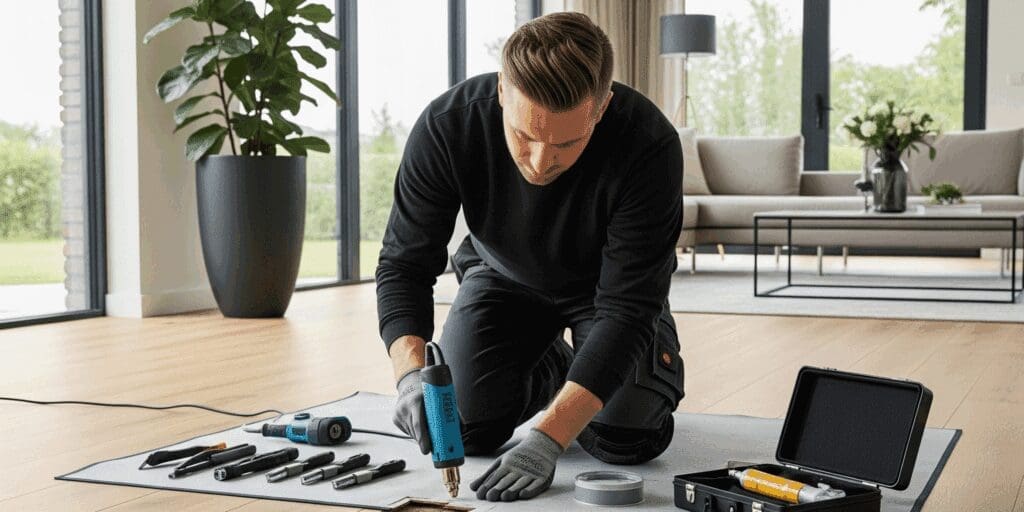Flooring Advice & How To Guides, Flooring Repair Guides
Laminate Flooring Repair Guide
Fixing Scratches, Chips, and Water Damage
Laminate flooring is a popular choice for many homes, offering a durable, attractive, and cost-effective alternative to real wood. However, like any flooring, it can be susceptible to damage from everyday life, such as scuffs, chips from dropped objects, or swelling from moisture. This guide provides comprehensive, customer-friendly instructions on how to repair these common issues. By following these steps, you can restore your floor’s pristine appearance and extend its life. Always work carefully and consider safety precautions, such as wearing a dust mask and safety goggles when cutting or sanding.
Tools and Materials Checklist
The tools and materials you’ll need will vary depending on the repair. Here’s a general list to cover most situations:
- Laminate floor repair kit (typically includes wax filler sticks, a melting tool, and a spatula)
- Laminate repair paste or putty
- Matching touch-up marker pen or crayon
- Utility knife or chisel
- Putty knife or flat-bladed tool
- Clean, soft cloths or microfibre rags
- High-quality wood or laminate-specific adhesive
- Rubber mallet and tapping block
- A pry bar or flat-bladed tool
- Replacement laminate planks (if you have spares)
- Circular saw or jigsaw with a fine-tooth blade
- Vacuum cleaner and dustpan
- Safety goggles and a dust mask
Step-by-Step Repair Instructions
Choose the section that applies to your specific type of damage.
Repairing Scratches and Scuffs
The method you use depends on the depth of the scratch.
- Clean the Area: Before any repair, clean the damaged area thoroughly. Use a vacuum to remove all dust and debris, and then wipe with a clean, slightly damp cloth. Ensure the area is completely dry.
- For Minor Scratches: A touch-up marker pen or crayon that matches your floor’s colour can be used to simply fill in the scratch. Apply it directly to the scratch and then gently buff with a soft cloth to blend it in with the surrounding area.
- For Deeper Scratches or Chips: Use a laminate repair kit. These kits usually come with hard wax filler sticks in various shades. Select a colour that matches your floor. Use the included melting tool to melt the wax and fill the scratch or chip. Overfill the area slightly. Once the wax has cooled and hardened, use the spatula from the kit to carefully scrape away the excess, leaving a smooth, flush surface.
Fixing Peeling or Bubbling Edges
This issue is often caused by moisture exposure, but can be fixed if caught early.
- Clean and Dry: Thoroughly clean the peeling area and allow it to dry completely. If the bubbling or peeling is from a water spill, ensure the subfloor is also completely dry. A dehumidifier or fans can help.
- Apply Adhesive: Gently lift the peeling section of the laminate using a putty knife. Apply a small amount of high-quality wood or laminate adhesive underneath the peeling section. Use a fine-tipped applicator for precision.
- Secure the Plank: Press the laminate back into place, ensuring it is flat. Wipe away any excess glue immediately with a damp cloth. Place a heavy object, such as a stack of books or a heavy weight, on the repaired area to hold it firmly while the adhesive dries. Leave it for the recommended drying time (usually 8-12 hours or as per the manufacturer’s instructions).
Replacing a Damaged Plank
For severe damage, such as a large crack, a deep gouge, or significant water swelling, replacing the plank is the best option. The method depends on the location of the damaged plank.
Replacing a Plank at the Edge of the Room
- Disassemble the Floor: This is the simplest method. First, remove the skirting board from the wall. Carefully lift and un-click the planks, working your way from the wall until you reach the damaged plank.
- Replace and Reassemble: Once you have removed the damaged plank, simply click the new plank into its place. Reassemble the floor in reverse order, clicking the planks back together and finishing by replacing the skirting board.
Replacing a Plank in the Middle of the Room
- Cut out the Damaged Plank: Use a circular saw or an oscillating multi-tool to make two parallel cuts down the length of the damaged plank. Set the blade depth to match the thickness of the laminate to avoid cutting into the subfloor. Make a few cross-cuts and then use a chisel to carefully pry out the pieces.
- Prepare the New Plank: With the damaged plank removed, you need to prepare the new one. Use a saw or a utility knife to cut off the bottom groove of the new plank on the long and short side. This allows the plank to be dropped in flat rather than being clicked into place.
- Install the New Plank: Apply a bead of high-quality wood glue along the exposed tongues of the surrounding planks. Carefully lower the new plank into the gap, ensuring a tight fit. You may need to use a tapping block and rubber mallet to gently secure it. Wipe away any excess glue with a damp cloth.
- Set and Cure: Place heavy weights on the new plank for the adhesive to cure properly (as per instructions, typically 24 hours).
Troubleshooting and Prevention
Troubleshooting
- Planks are Gapping: Gapping can be caused by humidity changes. Use a tapping block and rubber mallet to gently tap the planks back together. If the gaps reappear, you may need to add a shim or adhesive to the joint.
- Repair Colour Doesn’t Match: For minor repairs, it can be tricky to find an exact colour match. You can often mix different colours of wax filler to achieve a closer match.
- Swelling is Severe: If water damage has caused significant swelling and warping, the plank is beyond repair and must be replaced.
Prevention
- Clean Regularly: Regularly sweep or vacuum to remove grit and dirt, which can scratch the surface over time. Use a damp cloth for spills and a pH-neutral cleaner for mopping.
- Use Protective Pads: Place felt pads or furniture glides on the legs of all furniture to prevent scratches and dents when objects are moved.
- Protect from Moisture: Laminate is not waterproof. Wipe up spills immediately and use mats near sinks, entryways, and other areas prone to moisture.
- Maintain Humidity: Keeping a stable temperature and humidity level in your home can prevent the planks from expanding and contracting, which can lead to gapping or buckling.

